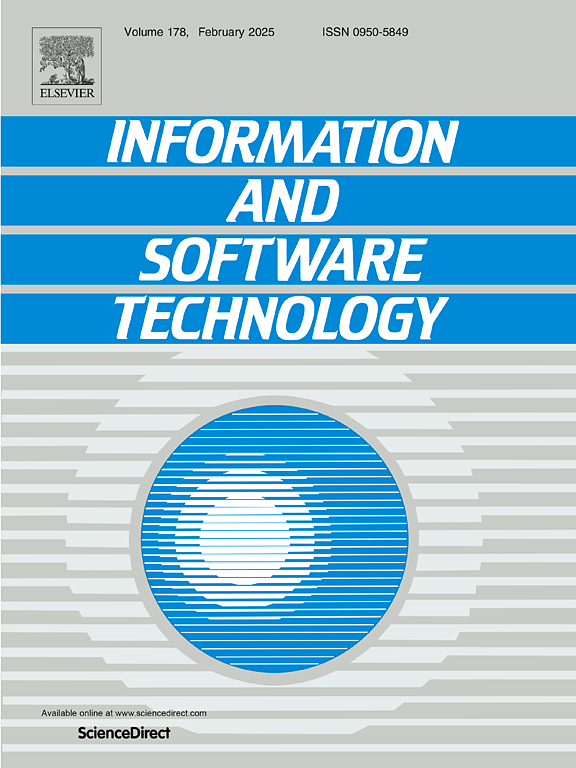Understanding the product knowledge acquisition process in multiprovider software evolution scenarios: An exploratory study
IF 4.3
2区 计算机科学
Q2 COMPUTER SCIENCE, INFORMATION SYSTEMS
引用次数: 0
Abstract
Context
The life cycle of a custom software system involves multiple evolution projects, where each one can be carried out by a different provider, i.e., software development company. When the provider changes, the new one should understand the structure and functionality of the product to evolve, in order to determine the scope, effort, risks and uncertainties of the next evolution project. Regardless of its relevance in practice, product comprehension has received little attention, particularly in multiprovider evolution scenarios. This limits the ability of researchers and practitioners to understand and improve this process.
Objective
To understand the process performed by software teams to discover and assimilate the knowledge about the structure, functionality, and quality aspects of a custom system developed by another team.
Method
We conducted an exploratory study that answered four research questions considering two particular software evolution scenarios. The study involved interviews with 19 project leaders from Chilean and Brazilian small and medium-sized enterprises, who regularly participate in this type of project.
Results
For each evolution scenario, we identified: (1) the underlying structure and dynamic of the product knowledge acquisition process, (2) the knowledge gathering activities and software artifacts used by the development teams, and (3) how effective these teams were when performing these activities. The study also identifies causes of low effectiveness of teams in this process and promising research avenues to address them.
Conclusion
The product knowledge acquisition process is usually informal and has low cost-effectiveness. Provider switching results in an important loss of information and knowledge about the structure and functionality of the product, which limits comprehension and evolution of the system. The results show a clear need to change the status-quo in the customer-provider relationship in the study scenarios, and open several research opportunities to improve this process.
理解多提供商软件演进场景下的产品知识获取过程:探索性研究
定制软件系统的生命周期涉及多个演进项目,其中每个项目都可以由不同的提供者(即软件开发公司)执行。当提供者变更时,新的提供者应该了解要演进的产品的结构和功能,以便确定下一个演进项目的范围、工作、风险和不确定性。无论其在实践中的相关性如何,产品理解很少受到关注,特别是在多提供商演进场景中。这限制了研究人员和从业者理解和改进这一过程的能力。目的了解由软件团队执行的过程,以发现和吸收由另一个团队开发的定制系统的结构、功能和质量方面的知识。方法我们进行了一项探索性研究,考虑到两个特定的软件进化场景,回答了四个研究问题。该研究采访了来自智利和巴西中小企业的19位项目负责人,他们经常参与这类项目。结果对于每个演进场景,我们确定:(1)产品知识获取过程的底层结构和动态,(2)开发团队使用的知识收集活动和软件工件,以及(3)这些团队在执行这些活动时的效率。该研究还确定了在此过程中团队效率低的原因以及解决这些问题的有希望的研究途径。结论企业产品知识获取过程不规范,成本效益不高。提供者的切换会导致关于产品结构和功能的重要信息和知识的丢失,从而限制了系统的理解和发展。结果表明,在研究场景中,明显需要改变客户-提供者关系的现状,并打开几个研究机会来改进这一过程。
本文章由计算机程序翻译,如有差异,请以英文原文为准。
求助全文
约1分钟内获得全文
求助全文
来源期刊

Information and Software Technology
工程技术-计算机:软件工程
CiteScore
9.10
自引率
7.70%
发文量
164
审稿时长
9.6 weeks
期刊介绍:
Information and Software Technology is the international archival journal focusing on research and experience that contributes to the improvement of software development practices. The journal''s scope includes methods and techniques to better engineer software and manage its development. Articles submitted for review should have a clear component of software engineering or address ways to improve the engineering and management of software development. Areas covered by the journal include:
• Software management, quality and metrics,
• Software processes,
• Software architecture, modelling, specification, design and programming
• Functional and non-functional software requirements
• Software testing and verification & validation
• Empirical studies of all aspects of engineering and managing software development
Short Communications is a new section dedicated to short papers addressing new ideas, controversial opinions, "Negative" results and much more. Read the Guide for authors for more information.
The journal encourages and welcomes submissions of systematic literature studies (reviews and maps) within the scope of the journal. Information and Software Technology is the premiere outlet for systematic literature studies in software engineering.
 求助内容:
求助内容: 应助结果提醒方式:
应助结果提醒方式:


